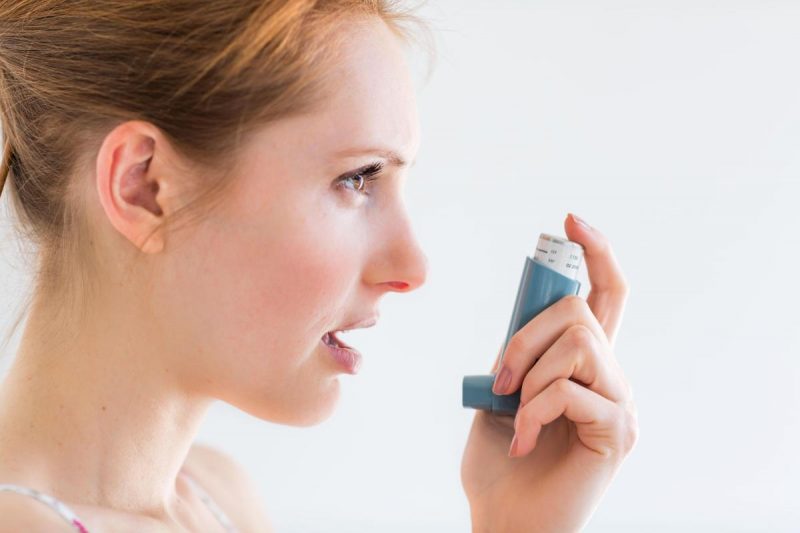Due to the increased sensitivity of the respiratory tract, the development of inflammatory processes in the tissues of the bronchial tree can occur under the influence of not only external but also internal stimuli. By controlling the symptoms and treatment of bronchial asthma in adults, pulmonologists can achieve normalization of respiratory functions and prevent the appearance of new attacks of suffocation.
In order to stop possible complications in time, patients with impaired respiratory functions should be informed how asthma begins, and when the first signs appear, consult a doctor.
Material Content:
Bronchial asthma in adults: causes
Bronchial asthma is a chronic pathology of the respiratory tract, which is characterized by damage and swelling of the mucosa, as well as narrowing of the lumen of the bronchi, up to the obstruction of the respiratory tract.

The disease is characterized by a progressive course and is accompanied by periodic attacks of suffocation.
According to WHO statistics, there are about 300 million people with bronchial asthma in the world.
The development of the disease can be triggered by various external factors:
- genetic predisposition. Cases of hereditary vulnerability in asthma are not uncommon. Sometimes the disease is diagnosed in representatives of each generation. If the parents are sick, the chance of avoiding pathology in the child is no more than 25%;
- exposure to the professional environment.Damage to the respiratory tract by harmful fumes, gas and dust is one of the most common causes of asthma;
- allergens. Characteristic attacks of suffocation most often occur under the influence of external irritants - tobacco smoke, wool, feathers and particles of animal skin, dust mites, mold, strong odors, pollen and even cold air;
- irritants (triggers) of the bronchial mucosa - detergents, aerosols, certain medications, sulfites in food, as well as severe nervous and emotional upheavals.
Internal factors contributing to the development of bronchial hyperreactivity include endocrine and immune system dysfunctions.
The most common complications of bronchial asthma are diagnosed in patients who are prone to overweight, preferring digestible carbohydrates and animal fats. Whereas in people whose diet is dominated by herbal products, the disease is easy and severe asthma is extremely rare.
Symptoms of the disease
Under the influence of pathogenic and allergenic factors, bronchial hyperreactivity occurs - increased irritability of the shell of the bronchial walls, a key link in the development of asthma of any type.

With an increase in bronchial reactivity, characteristic symptoms of asthma are observed:
- shortness of breath, panting, choking. They arise as a result of contact with an irritating factor;
- attacks of dry cough, more often, at night or in the morning. In rare cases, it is accompanied by a slight secretion of transparent sputum mucosa;
- dry rales - sounds of a whistling or creaking character that accompany breathing;
- difficulty exhaling against a full breath. To exhale, patients have to take an orthopnea pose - sitting on the bed, grab hold of its edge with his hands, resting his feet on the floor. The fixed position of the patient facilitates the exhalation process;
- respiratory failure causes general weakness, inability to perform physical work and is accompanied by cyanosis of the skin;
- headaches and dizziness;
- violation of cardiac activity - increased heart rate, up to bradycardia. On the ECG, an overload of the right heart is observed;
- loss of consciousness, cramps.
Short-term nocturnal manifestations of increased bronchial reactivity are considered early signs of asthma. If during this period you turn to doctors and undergo a course of treatment, the prognosis of your health condition will be as favorable as possible.
ICD 10 bronchial asthma
According to the International Classification of Diseases, the term "bronchial asthma" is appropriate in the diagnosis of pathologies corresponding to a certain classification. The main parameters for determining the type of disease are its origin and severity.

Due to etiological signs, the following groups of bronchial asthma are distinguished according to ICD 10:
- J.45. bronchial asthma, with the exception of chronic asthmatic bronchitis;
- J.45.0. atopic bronchial asthma, provided that one of the external allergens is detected;
- J.45.1. non-allergic asthma, including endogenous and medication non-allergic;
- J.45.8. mixed form - professional, aspirin, asthma of physical stress;
- J.45.9.unspecified, including asthmatic bronchitis and late-onset bronchial asthma;
- J.46. Asthmatic status is the most acute, life-threatening form of manifestation of pathology.
In addition, many scientists insist on the classification of asthma by signs of pathogenic effects. The atopic species includes pathologies of the bronchi that have arisen under the influence of allergens - non-infectious-atopic, infectious-atopic and mixed.
Pseudo-atopic type asthma is characteristic of patients with impaired regulation of bronchial tone - aspirin, infectious due to physical exertion.
Thanks to the ICD-10 classification, not only an accurate diagnosis has been simplified, but also the ability to organize adequate medical care.
Stages of the disease
The severity of asthma is classified as follows:
| Severity | Characteristics of daytime symptoms | Frequency of nightly symptoms |
|---|---|---|
| Intermittent | Attacks no more than once a week. No other signs | Attacks no more than twice a month |
| Persistent light | Attacks more than once a week, but not more than once a day. Exacerbations that impair physical activity are possible. | More than twice a month |
| Persistent moderate | Daily exacerbations observed | More than once a week |
| Persistent heavy | Complete restriction of physical activity | Frequent |
The first stage of asthma is intermittent, characterized by episodic attacks in the daytime and at night. Movement activity and ability to talk is maintained at a natural level.
The second stage of development is a persistent lung, accompanied by frequent seizures and prolonged exacerbations. The patient's well-being worsens, insomnia is observed at night.
This form of pathology is characterized by a decrease in respiration. However, the physical and mental condition of the patient remains stable.
The third stage of asthma is persistent moderate, accompanied by severe dysfunction of the respiratory system and damage to the bronchi.
The fourth stage of the course of bronchial asthma is regarded as the most complex, life-threatening. The attacks are long, difficult to stop. Edema of bronchioles contributes to the accumulation of a large amount of thick sputum. As suffocation increases, tissue hypoxia is possible.
Why is bronchial asthma dangerous?

In the absence of adequate treatment, bronchial asthma leads to the development of severe complications:
- pulmonary emphysema - an irreversible pathological expansion of the lumen of bronchioles, accompanied by organ destruction;
- infectious bronchitis. The accession of secondary infections is a consequence of a weakening of the functions of the immune and respiratory systems. The causative agents of infection can be not only viruses, but also bacteria or fungi;
- pulmonary heart - an abnormal increase in the size of the right heart. With the development of decompensation, it leads to heart failure and death.
Other complications caused by asthmatic processes in the bronchi include ruptures of the lungs, accumulation of air in the pleural cavity, obstruction of the lungs with sputum, impaired pulmonary ventilation, replacement of the functional lung tissue with connective tissue, as well as metabolic, gastrointestinal and brain lesions.
Treatment of asthmatic complications is possible only against the background of the elimination of disorders caused by the underlying disease.
Diagnosis of the disease
Even with the characteristic symptoms of bronchial asthma, an accurate diagnosis is only possible after a full examination.

Diagnostic measures include the following studies:
- determination of indicators of the respiratory system functionality, in particular, parameters of external respiration - total tidal volume, reserve volume of inspiration and expiration, residual volume of the lungs;
- identification of a tendency to allergies through tests;
- sputum analysis;
- blood tests;
- Radiography eliminates other pathologies of the respiratory system.
A standard examination of the patient at the stage preceding the onset of asthma does not detect the characteristic features of the disease. To obtain the necessary information, additional diagnostic methods are used.
Bronchial asthma treatment
Methods of treating bronchial asthma include two types of medical care - planned, designed to gain control of the disease, and urgent, providing relief of attacks at the time of exacerbation.
Maintenance therapy
The choice of therapeutic decisions depends on the type and severity of the course of the disease.
Since the first stage of the disease is regarded as controlled, the basic treatment used is designed to eliminate the cause of asthma, neutralize exacerbations, and maximize the potential of the immune system.

For this purpose, inhalations of b2-agonists and other bronchodilators, Intral and Tiled cromons, as well as short-acting theophylline are prescribed.
If the need for inhalers increases, this means that control of the disease is lost and more intensive treatment is needed.
Pulmonologists use inhaled glucocorticosteroids and immunocorrective therapy to regain control of the disease.
Relief of acute attacks with drugs
At the time of exacerbation of bronchial asthma, it is necessary to release the patient’s breathing as much as possible - unfasten the collar, take off his tie, provide access to fresh air. Then fast-acting veta-agonists, tablet glucocorticosteroids and anticholinergics are used, and they necessarily call an ambulance.
Treatment with folk remedies

Traditional medicine recommends that asthmatics relieve the condition with the help of tea from oregano, infusion of oats, inhalation with ginger essential oil, and decoction of herbal herbs. In addition, patients with asthma are shown the use of salt lamps and halotherapy.
Prevention of bronchial asthma in adults
Prevention of asthmatic disease is necessary not only for patients with an established diagnosis, but also for people at risk - smokers, allergies, relatives of patients.
The main preventive measures include:
- elimination of allergens or minimizing contact with them;
- quitting smoking and other bad habits;
- regular maintenance of hygiene measures in the room;
- timely replacement of old furniture, beds, curtains and other furnishings;
- healthy food, the exclusion of products containing preservatives and flavorings;
- refusal of any pets
To enhance health, an annual stay in spa facilities is also recommended.












